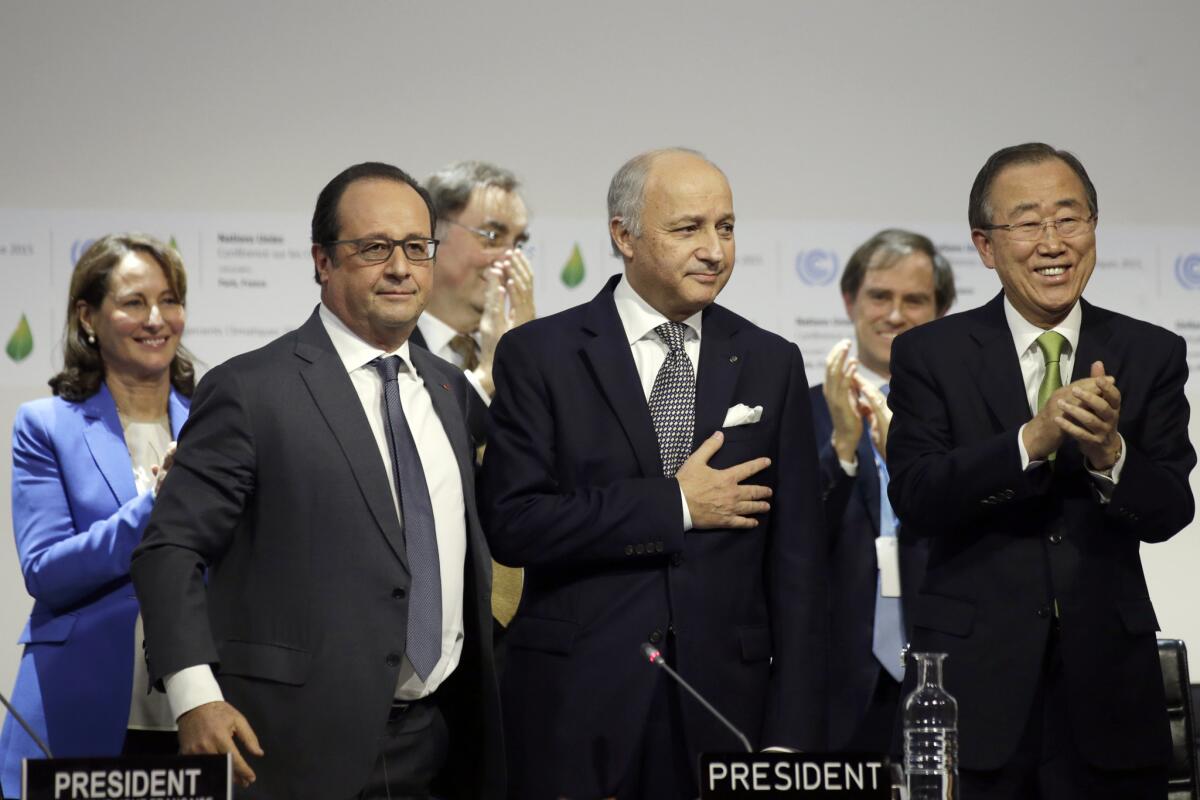Nearly 200 nations join together to fight climate change in historic Paris agreement

French Foreign Minister Laurent Fabius puts his hand over his heart after his speech at Le Bourget, outside Paris. Flanking him are French President Francois Hollande, left, and U.N. Secretary-General Ban Ki-moon.
Representatives from nearly 200 countries made common cause in the fight against climate change Saturday, adopting an agreement they hope will avert some of the worst effects of global warming and shift economies around the world to cleaner energy sources.
The agreement reached at a United Nations conference outside Paris marks the first time that virtually every nation on Earth has committed to reducing greenhouse gas emissions. The long-term goal is to limit the average global temperature rise since preindustrial times to well below 2 degrees Celsius, the threshold at which scientists say many of the worst effects of global warming could be avoided.
Government leaders, environmental activists, scientists and others gathered here acknowledged that the measures outlined in the deal won’t solve the environmental crisis. But they said the pact establishes a framework for a truly global response to what they described as the defining challenge of our time.
“This agreement represents the best chance we’ve had to save the one planet that we’ve got,” President Obama told reporters at the White House.
“No nation, not even one as powerful as ours, can solve this challenge alone,” he said. “And no country, no matter how small, can sit on the sidelines. All of us had to solve it together.”
Gov. Jerry Brown of California, which emits about 1% of the world’s greenhouse gases, emphasized that the next step is for state and local officials, business leaders and investors around the world to begin taking the steps necessary to implement the agreement’s goals.
“This is a historic turning point in the quest to combat one of the biggest threats facing humanity,” said Brown, who attended the conference. “Activists, businesses and subnational leaders now need to redouble their efforts and push for increasingly aggressive action.”
Negotiators had struggled during two weeks of marathon talks to overcome long-standing divisions on fundamental issues such as the pact’s long-term goals, how to address the costs of dealing with climate change, how to define the responsibilities of countries in different stages of development and how to ensure that nations fulfill their commitments.
The conference hall erupted in loud applause when French Foreign Minister Laurent Fabius gaveled in the agreement Saturday night. Delegates hugged one another, and some broke into tears.
“Now comes the great task of the century: How do we meet this new goal?” Kumi Naidoo, international executive director at Greenpeace, said at a news conference. “The measures outlined in Paris simply don’t get us there.”
In addition to setting the 2-degree temperature goal, nations also agreed to pursue efforts to limit warming this century to 1.5 degrees Celsius, a more ambitious target that had been pushed by countries already threatened by rising seas, prolonged droughts and extreme storms and flooding.
To achieve these objectives, the agreement relies on countries to set their own targets to phase out the use of fossil fuels and reduce greenhouse gas emissions. But the proposals currently on the table are projected to keep the temperature rises closer to 3 degrees Celsius.
That is why the conference organizers pressed negotiators to agree to a system to regularly review progress and ratchet up commitments every five years beginning in 2020.
“This agreement, your agreement, is not an end in itself,” French President Francois Hollande said at the closing session of the summit. “It is only the beginning.”
One of the most difficult issues tackled at the conference concerned money: which countries should pay for what and how much they should pay.
Developing countries have long argued that countries that grew rich by using coal, oil and other fossil fuels should shoulder the burden of moving the world’s economies to cleaner energy sources and help poor nations cope with the effects of climate change.
Wealthy countries pledged to mobilize no less than $100 billion a year by 2020 to help developing nations and to ramp up their contributions by 2025, a provision that India had wanted in the deal. But vulnerable nations were disappointed that the agreement does not guarantee assistance to those countries that will suffer the biggest effects of global warming.
The document recognizes demands for loss and damage compensation, but at the expense of a clause excluding any liability claims, said Tim Gore, policy director at the British charity Oxfam. The world’s poorest have been “shortchanged,” he said.
Neither the funding pledges nor the emissions goals set by countries are binding under international law.
Secretary of State John F. Kerry was adamant in the days before the conference that the U.S. could not commit to legally binding targets, in part because that could require approval by the Republican-controlled Senate, which has soundly opposed the Obama administration’s climate goals. Instead, the U.S. pressed for a robust system to track, report and verify whether countries are living up to their pledges.
That isn’t necessarily a weakness, said John Copeland Nagle, law professor at Notre Dame University.
“Gone are the days when we believed that only a legally binding treaty could produce an effective response to climate change,” he said in a statement. “The Paris agreement is all about voluntary actions. Each country chooses its own emissions target. Then each country may ‘choose to pursue voluntary cooperation’ to reach those targets in a way that will ‘promote sustainable development and environmental integrity.’”
Scientists said the agreement set strong temperature goals that were in line with the latest research. How meaningful that is will depend on the willingness of countries to strengthen their commitments on an accelerated time frame, said Lou Leonard, vice president of the World Wildlife Fund. Financing and emissions-reduction pledges will need to be scaled up before 2020 to provide any chance of limiting warming to 1.5 degrees Celsius, he said.
The agreement reflects the first universal environmental accord since signatories to the United Nations Framework Convention on Climate Change began holding meetings around the world in the early 1990s.
In 1997, in Kyoto, Japan, only developed countries agreed to emissions cuts. The United States, however, was not among them because the agreement was never approved by the U.S. Senate. In 2009, a major pact seemed possible at the conference held in Copenhagen, but that effort ended in complaints of secrecy and disorder — and without a binding deal.
Much has happened in the six years since. The world has endured record high temperatures and extended drought and wildfires in places like Australia and the American West. Other parts of the world have seen extreme storms such as Superstorm Sandy, melting polar ice sheets and rising seas.
Environmental groups have become more unified and galvanized around climate concerns. Scientists have developed increasingly precise models showing how global warming could affect places like Miami Beach, much of which could be underwater late in the century, and ski towns in the Rocky Mountains, many of which may no longer receive enough snow to draw winter tourists by 2050 or so.
Religious leaders, Pope Francis most notably, have made climate change a new priority, portraying it as a matter of social justice that has disproportionately affected poor nations, even though it is the developed world that has contributed most to the problem.
Meanwhile, China, the world’s largest generator of carbon emissions, has battled crippling air pollution from coal-fired power plants. This week, smog blanketed Beijing and prompted the country to issue its first “red alert.”
A year ago, China joined with the United States, the world’s second-largest emitter, in a bilateral agreement to reduce greenhouse gases. That move is one of many Obama has made, using executive action to work around Congress. The president has also increased restrictions on vehicle emissions and, on Dec. 22, his Clean Power Plan, which reduces carbon emissions from power plants, is scheduled to take effect (amid a contentious legal fight to halt it).
But Obama has also overseen a domestic oil boom made possible by the rise of a controversial form of extraction known as hydraulic fracturing, or fracking. His “all-of-the-above” energy policy has included too much emphasis on fossil fuels for many environmentalists, but not enough for those who advocate developing more oil resources in, for example, the American Arctic.
Obama said the commitments made in Paris were a “tribute to American leadership,” which helped salvage the 2009 summit in Copenhagen and build the framework for Saturday’s agreement.
Obama conceded that the agreement was not perfect but said it would help delay or avoid some of the worst consequences of climate change. And over time, he said, it would lead to further action that will leave a cleaner environment that future generations — including his own potential grandchildren — could enjoy.
The Senate’s top Republican was quick to question the president’s exuberance, noting the legal challenge facing the administration’s Clean Power Plan, which is at the heart of U.S. commitments in the deal.
“The president is making promises he can’t keep, writing checks he can’t cash, and stepping over the middle class to take credit for an ‘agreement’ that is subject to being shredded in 13 months,” Senate Majority Leader Mitch McConnell (R-Ky.) said in a statement. “Before his international partners pop the champagne, they should remember that this is an unattainable deal based on a domestic energy plan that is likely illegal, that half the states have sued to halt, and that Congress has already voted to reject.”
Voters in the United States are divided on the need to address climate change.
A recent poll by the Pew Research Center found that more than half of those surveyed in 40 nations viewed climate change as a “very serious problem.” Nearly 80% supported an international agreement to limit greenhouse gas emissions. The highest rates of concern were in Latin America, Africa and Europe.
In the United States, only 45% viewed climate change as a very serious problem. In China, the figure was just 18%.
alexandra.zavis@latimes.com
chris.megerian@latimes.com
william.yardley@latimes.com
Zavis reported from Paris, Megerian from Le Bourget and Yardley from Seattle. Times staff writer Michael A. Memoli in Washington contributed to this report.
ALSO
Saudi women vote for the first time in landmark election
K-pop group denied entry at LAX on suspicion of being sex workers, band says
Ex-Oklahoma police officer guilty of raping black women ‘picked the wrong lady’
More to Read
Start your day right
Sign up for Essential California for news, features and recommendations from the L.A. Times and beyond in your inbox six days a week.
You may occasionally receive promotional content from the Los Angeles Times.









